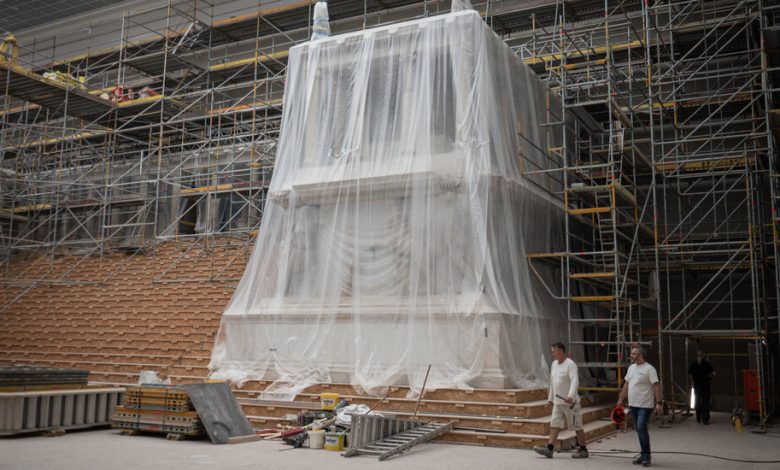Restitution Is Moving Quickly. The Pergamon Museum Is Taking It Slow.

Even wrapped in plastic, the Pergamon Altar is a striking sight. A monumental structure with ornate friezes depicting a battle between giants and gods, it was sculpted in what is now Turkey in the 2nd century B.C. and is one of the most imposing known examples of antique art. Housed in Berlin’s Pergamon Museum for over a century, the altar has long been one of the main attractions in the German capital.
That is, when visitors can see it. The altar has been inaccessible since 2014, amid construction work on the museum’s north wing. On Oct. 23, the rest of the museum — one of the most visited in Germany — will close for four years. Although the altar room and north wing are set to reopen in 2027, other parts of the building will not be accessible for a further decade.
The project comes at a delicate time. In recent years, European institutions exhibiting archaeological objects from other parts of the world, such as the Pergamon Museum, and the British Museum, in London, have faced increased scrutiny over the provenance of their exhibits. With more than $1.5 billion of public money being invested into the Pergamon Museum refurbishment, its leaders now face new calls to justify their work.
“The institution of the museum, as a product of the Enlightenment, is being questioned,” Andreas Scholl, the director of the Pergamon’s antiquities collection said during a recent tour of the site. “Nobody knows how the debate will progress.”
The Pergamon Museum’s administrators, however, are betting that much will remain the same in the next 14 years. In addition to structural work, the renovations will add new spaces for exhibits and visitors, and update infrastructure, lighting and climate control. But, as Scholl put it, “The fundamental concept isn’t changing.”
Opened in 1930 on Museum Island, in central Berlin, the building was custom-designed to showcase the altar and several other spectacular items of antique architecture, including parts of the so-called Ishtar Gate from the ancient city of Babylon.
But the building was built on oak pylons driven into unstable, sandy ground, and Jens Küchler, the project manager in charge of the renovations, said renewing its foundations was crucial for long-term stability. The work, he said, is partly focused on a metal underground structure stretching across the island that “holds up the building.”
The Pergamon Altar has always been the museum’s most prized attraction. Discovered in the 1870s by Carl Humann, a German engineer, its transfer to Berlin was made possible by a series of agreements between Ottoman Empire administrators and German officials that allowed Germany to retain a portion of the artifacts that Humann and his collaborators discovered.
But the justice of the exchange has been questioned in recent years as postcolonial activists have called for the return of exhibits acquired during the colonial period. The debate has been sharpened by the backlash against the Humboldt Forum, a new museum project in Berlin housing ethnological items in a reconstructed palace, which helped spur a landmark decision by the German government last year to return all the Benin Bronzes in its state-owned museums to Nigeria.
Public attention has also turned to other high-profile items in Berlin’s museums, such as the bust of Queen Nefertiti housed in the nearby Neues Museum. The museum acquired the bust, which is considered a crown jewel of the city’s collections, in 1920 after approval from Egyptian authorities, but some activists argue that this was a cozy deal between colonial powers, because France controlled Egypt’s antiquities department at the time. Museum officials insist it was legally obtained.
A similar debate has erupted around the Pergamon Altar. A 2021 book, “The Kaiser’s Treasure Hunter,” by Jürgen Gottschlich and Dilek Zapticioglu-Gottschlich, explored the ethical ambiguities of the exhibit’s acquisition.
In an interview, Gottschlich argued that the German authorities exerted unfair influence to get the complete altar to Berlin. Its excavation, he said, took place at a time when European powers were competing to acquire prominent exhibits for their museums, and he said that the Germans exploited the difficult financial positions of the Sultans ruling that area of the Ottoman Empire to extract disproportionate concessions. “Legally, a restitution process is hopeless,” he said. “But the story is morally unclean.”
Turkish politicians, including the mayor of the city of Izmir, which is near the excavation site, have called for the altar’s return. In 2022, Saraya Gomis, Berlin’s state secretary for diversity and anti-discrimination at the time, weighed in to support returning the altar, as well as the Nefertiti bust. She told the Tagesspiegel newspaper that, from her perspective, “all the cultural items from other world regions do not belong to us.”
In an emailed statement, a spokesman for the German Foreign Ministry said that it had received no “requests regarding restitution” for the objects by Egypt or Turkey.
Hermann Parzinger, the president of the Prussian Cultural Heritage Foundation, which oversees Berlin’s major museums, including the Pergamon Museum, Neues Museum and part of the Humboldt Forum, said that there was “a different awareness now among visitors” of provenance questions and that he felt “museums needed to answer them.”
He said that although the debate has been omnipresent, the number of formal requests received by all the museums he oversaw was still low, at around “five to seven” in recent years. He emphasized that both the Pergamon Altar and the Nefertiti bust were “clear cases” of legal acquisitions. “There will be no restitution” of the two objects, he said.
“We need to show visitors that collections’ histories are inseparable from political history,” he said, but added: “The future cannot be that German museums only show German art.”
Before the altar was closed to the public in 2014, nearly approximately 1.3 million visitors came to the Pergamon Museum annually. That number has dipped since then, with approximately 800,000 annual museumgoers in 2019. Ticket sales are a significant moneymaker for the Prussian Cultural Heritage Foundation, and the Pergamon’s closure will be a financial burden.
On a recent Wednesday, the building was packed with visitors aiming to see its collection of Islamic art and items from the region encompassing what is now Iraq, Syria and Turkey before it closes its doors.
Bernd Mikuszeit, 80, said he had been visiting the Pergamon since the 1960s and that, while he was aware of the concerns around ownership of the altar, it had done little to change his appreciation of the museum. “This isn’t Turkish history, it’s world history,” he said. “If our forefathers hadn’t saved it from the rubble, it wouldn’t exist,” he added.
A visitor from Montreal, Daniel Bühler, 23, said institutions like the Pergamon were a crucial way to experience global culture. “If everything was sent back to the home country,” he said, “you wouldn’t have museums like this.”




